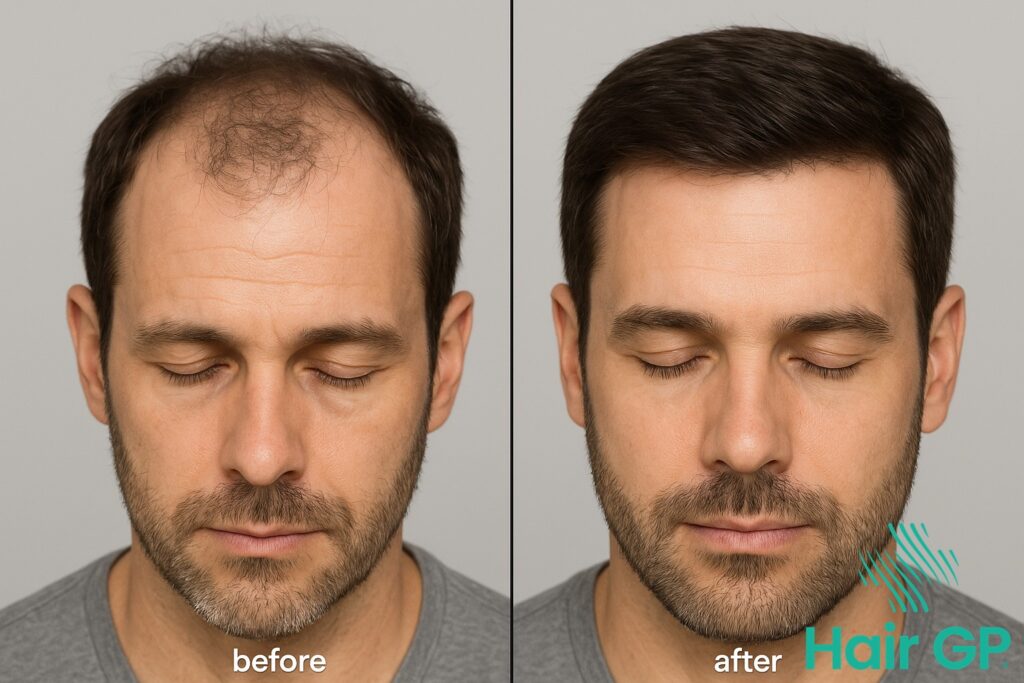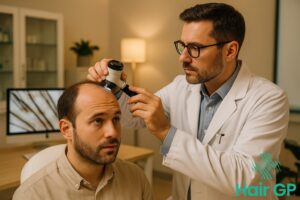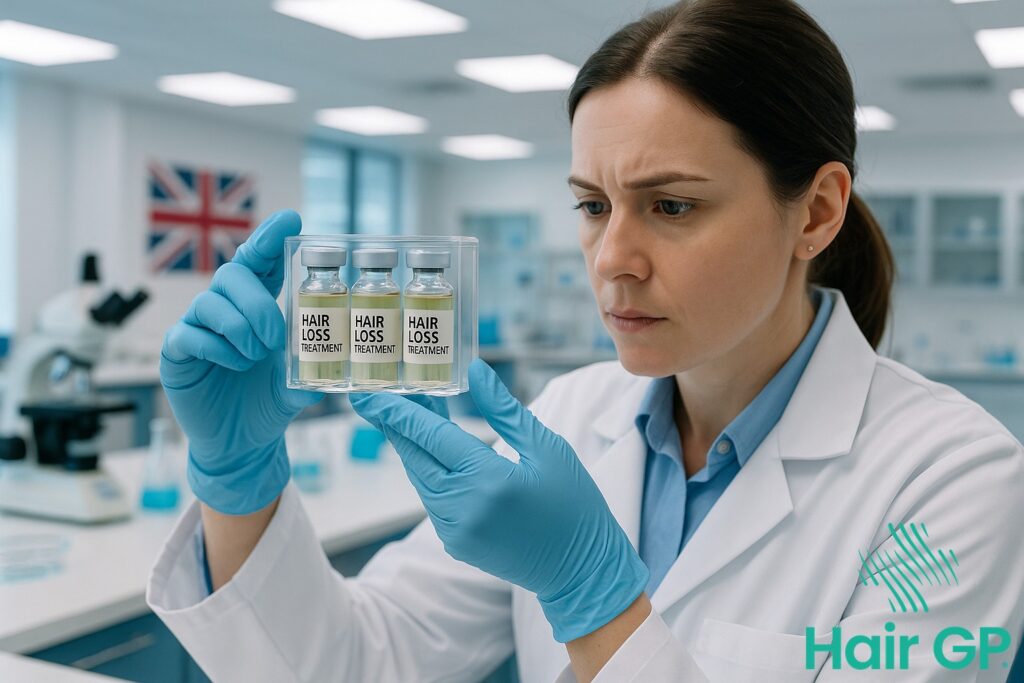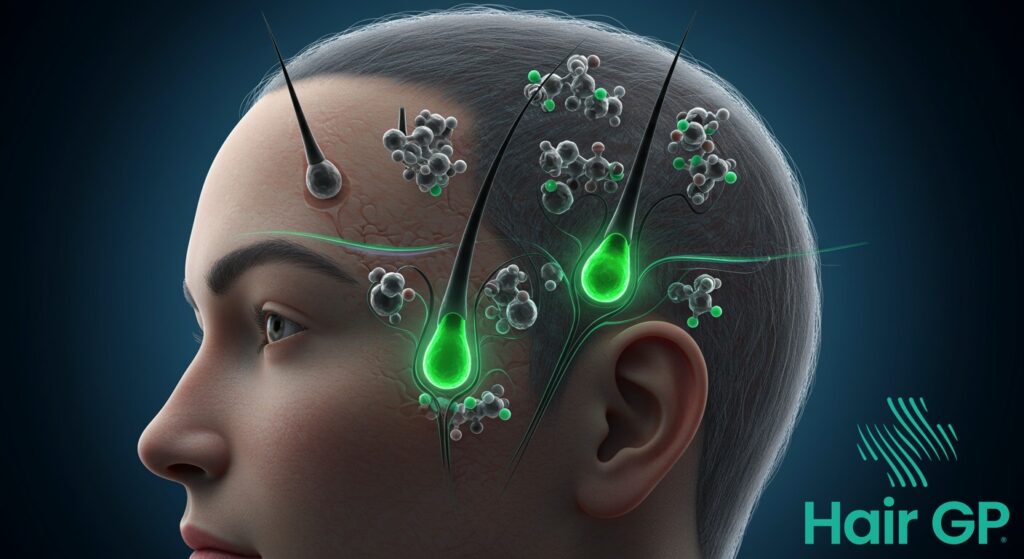Introduction
For millions experiencing hair loss, regenerative medicine offers promising solutions through innovative treatments that harness the body’s natural healing abilities. Two leading approaches in modern hair restoration are stem cell therapy and platelet rich plasma (PRP) treatment, each offering unique pathways to stimulate hair regrowth and combat thinning.
Whilst both treatments represent cutting-edge advances in regenerative medicine, they work through fundamentally different biological mechanisms. PRP utilises concentrated growth factors from your own blood to awaken dormant follicles, whilst stem cells employ cellular regeneration to create new hair growth possibilities. Understanding these distinctions is crucial for anyone considering non-surgical hair restoration options.
This comprehensive guide will walk you through how each treatment works, from the extraction process to the science behind follicle stimulation. We’ll compare their effectiveness for various types of hair loss, examine cost considerations and accessibility, and help you determine which approach might best suit your specific needs. Whether you’re dealing with genetic pattern baldness, stress-related thinning, or other forms of hair loss, you’ll gain the knowledge needed to make an informed decision about your hair restoration journey.
Key Takeaways – TL/DR
- PRP therapy uses your own blood platelets to stimulate existing hair follicles, while stem cell treatment can potentially regenerate new hair follicles
- Both treatments are minimally invasive but differ significantly in cost, with stem cell therapy being 3-5x more expensive
- PRP requires multiple sessions every 3-6 months, while stem cell treatments may offer longer-lasting results
- Neither treatment works for complete baldness – both require some existing hair follicles to be effective
Understanding PRP Therapy for Hair Restoration
Platelet rich plasma therapy harnesses the body’s natural healing capabilities by concentrating growth factors from a patient’s own blood to rejuvenate dormant hair follicles. This innovative treatment stimulates cellular regeneration within the scalp, promoting natural hair regrowth through a minimally invasive process.
The PRP Treatment Process
PRP treatment begins with a simple blood collection, typically drawing 10-20ml from the patient’s arm. The blood undergoes centrifuge separation, spinning at high speeds to isolate the platelet-rich layer from other blood components. This concentrated plasma contains growth factor levels 3-5 times higher than normal blood [1]. The final step involves precise PRP injections directly into the scalp’s affected areas, targeting dormant hair follicles with micro-injections spaced approximately 1cm apart across the treatment zone.
How PRP Stimulates Hair Growth
Once injected, platelets release multiple growth factors including PDGF, VEGF, and EGF, which activate cellular regeneration pathways. These growth factors promote angiogenesis, creating new blood vessels that enhance nutrient delivery to hair follicles [2]. The increased vascular supply triggers cell proliferation within the dermal papilla, extending the anagen (growth) phase of the hair cycle. Additionally, PRP therapy reduces inflammation around follicles and activates stem cells in the bulge region, collectively reversing miniaturisation and restoring healthy hair growth patterns.
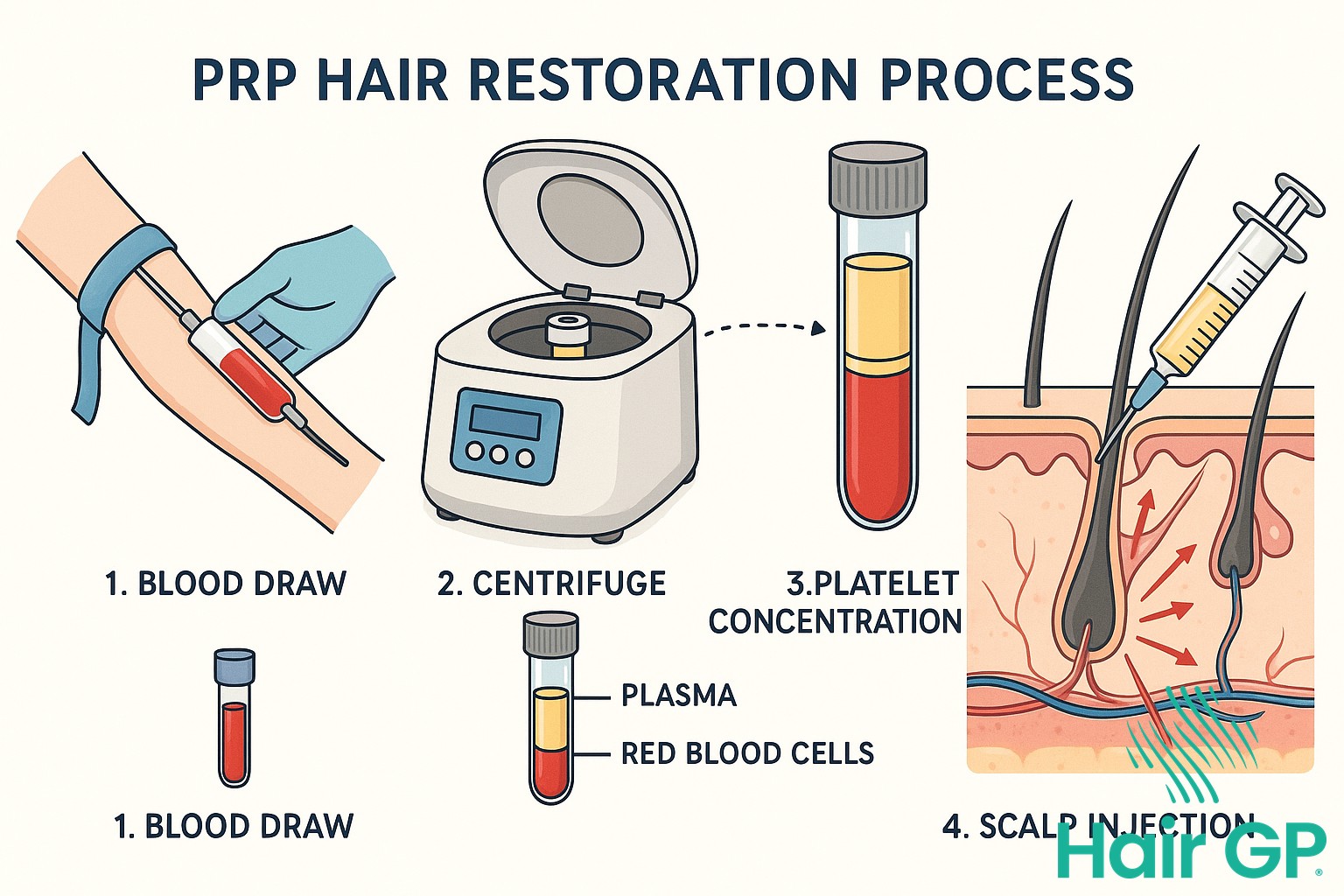
How Stem Cell Hair Treatment Works
Stem cell therapy for hair restoration harnesses the remarkable regenerative capabilities of adult stem cells to combat hair loss by creating new hair follicles and revitalising dormant ones. This advanced treatment works by extracting stem cells from the patient’s own body, processing them to concentrate their regenerative properties, and injecting them into areas affected by hair loss[3].
Types of Stem Cells for Hair Restoration
The most commonly utilised adult stem cells in hair restoration are adipose-derived stem cells, extracted from fat tissue typically harvested from the abdomen or thighs through minimally invasive liposuction. These mesenchymal stem cells possess exceptional potential to regenerate hair follicles due to their ability to differentiate into multiple cell types[4]. Bone marrow-derived stem cells represent another viable option, though adipose extraction methods are generally preferred due to easier accessibility and higher cell yields. The extraction process involves harvesting tissue, isolating stem cells through centrifugation, and preparing concentrated solutions for injection.
The Regeneration Process
Once injected into the scalp, stem cells initiate complex biological processes that promote hair growth. Through cellular differentiation, these cells transform into various specialised cells needed for follicle formation, including dermal papilla cells crucial for hair development. The stem cell treatments stimulate tissue regeneration by releasing growth factors that activate dormant follicles and encourage the formation of new hair follicles. This cell regeneration process continues for months following treatment, gradually improving hair density and thickness as newly formed follicles mature.
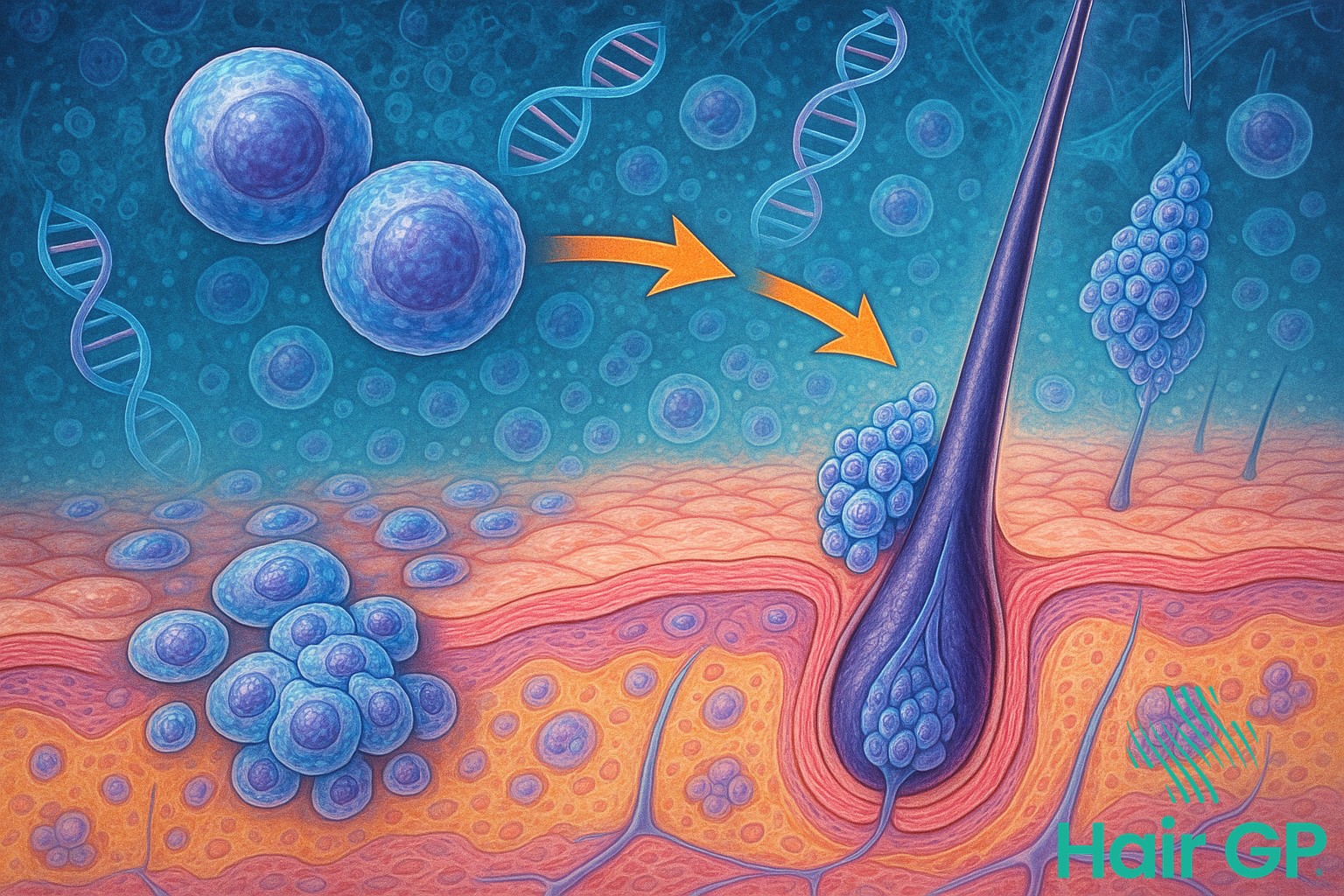
Key Differences Between Stem Cells and PRP
Whilst both stem cell therapy and PRP treatments offer non-surgical solutions to promote hair regrowth, they differ significantly in how they work, their treatment protocols, and expected outcomes. Understanding these key differences is essential for selecting the most appropriate treatment based on your specific hair loss pattern and goals.
Mechanism of Action
PRP therapy works by concentrating growth factors from your own blood to stimulate dormant hair follicles and strengthen existing hair follicles. The platelets release proteins that enhance blood supply and nourish follicular cells. In contrast, stem cells have the remarkable ability to regenerate damaged tissues and potentially create entirely new hair follicles. These multipotent cells differentiate into various cell types, including those that form hair structures, offering a more comprehensive regenerative approach through complex biological pathways.
Treatment Duration and Frequency
The treatment schedules differ considerably between these approaches. PRP requires multiple sessions, typically three to four initial treatments spaced one month apart, followed by maintenance sessions every three to six months. Stem cell therapy often involves a single treatment session, though some protocols may recommend a follow-up treatment after six months. The maintenance requirements for stem cells are generally less demanding, with many patients experiencing sustained results without frequent repeat procedures.
Expected Results Timeline
Patience is required with both treatments, though timelines vary. PRP patients typically observe initial improvements within three to six months, with hair appearing thicker and fuller. Stem cell results emerge more gradually, usually becoming noticeable between six to twelve months post-treatment. However, stem cell therapy often provides longer-lasting results, with many patients maintaining improvements for several years. The longevity of results depends on individual factors, including the severity of hair loss and overall health.
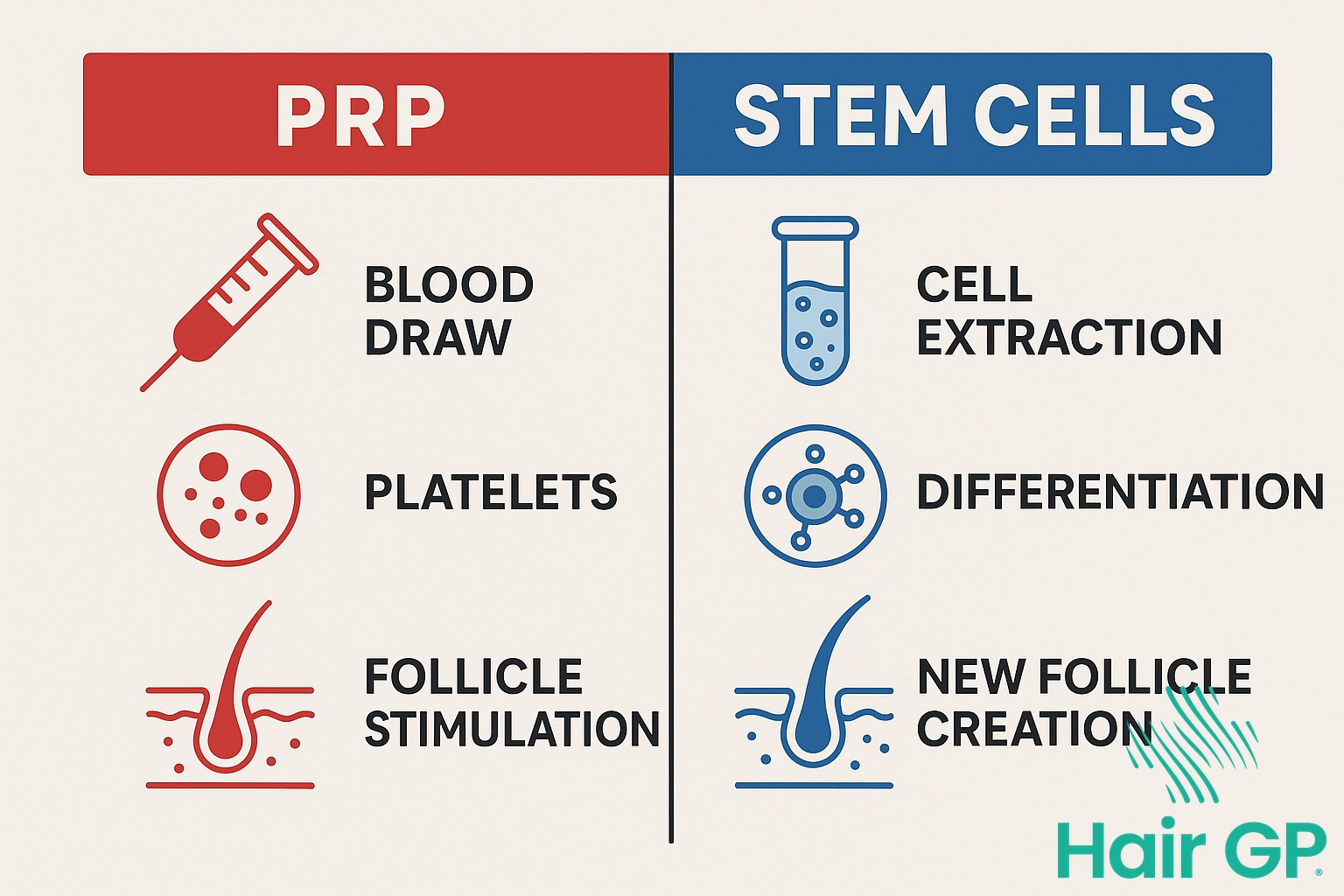
Effectiveness for Different Hair Loss Conditions
The effectiveness of stem cell and PRP therapies varies significantly across different hair loss conditions. For androgenetic alopecia, the most common form affecting both men and women, PRP demonstrates promising outcomes with approximately 60-70% of patients experiencing improved hair density after 3-4 monthly sessions [5]. Stem cell therapy shows even higher success rates for this condition, with studies reporting up to 80% improvement in hair count and thickness.
Alopecia areata, an autoimmune condition causing patchy hair loss, responds differently to these treatments. PRP therapy achieves moderate success, with complete regrowth in 45% of cases involving localised patches [6]. However, extensive alopecia areata shows limited response to both treatments, particularly when significant hair loss exceeds 50% of scalp coverage.
General hair thinning caused by nutritional deficiencies, stress, or hormonal changes typically responds well to both therapies. PRP effectively addresses diffuse thinning, whilst stem cell treatments excel in cases requiring follicular regeneration. The ability to combat hair loss depends largely on the underlying cause and severity. Early intervention yields superior results, as both treatments work best when viable follicles remain. Neither therapy effectively treats scarring alopecia, where permanent follicular damage has occurred, highlighting the importance of proper diagnosis before treatment selection.
Cost Comparison and Accessibility
Understanding the financial aspects of hair restoration treatments helps patients make informed decisions. PRP procedures typically range from £500-£600 per session, whilst stem cell therapy works out considerably higher at £2,000-£6,000 per treatment cycle. These costs vary significantly based on geographic location, with metropolitan areas commanding premium prices compared to suburban clinics.
Insurance rarely covers either treatment as they’re considered cosmetic procedures. However, payment plans are increasingly available through clinics. Geographic accessibility differs markedly between treatments—PRP is widely available across the UK, whilst stem cell options remain limited to specialist centres. When seeking a qualified hair restoration specialist, ensure they offer transparent pricing structures. Some practitioners combine PRP with other treatments like hair transplants to enhance results, potentially affecting overall costs. Location, clinic reputation, and treatment complexity remain the primary factors influencing final pricing for both options.
Making the Right Choice for Your Hair Restoration
Selecting the right treatment depends on your specific hair loss pattern, budget, and desired outcomes. For early-stage thinning where you want to strengthen existing hair and improve hair thickness, PRP may suffice. However, severe hair loss often responds better to stem cell therapy’s regenerative capabilities. Many patients achieve optimal hair regrowth through combination treatments, using both approaches to promote hair growth comprehensively. Consulting a qualified hair restoration specialist is crucial for developing a personalised treatment plan. They can assess your condition, discuss realistic expectations for achieving thicker hair, and recommend the most effective approach for your circumstances.
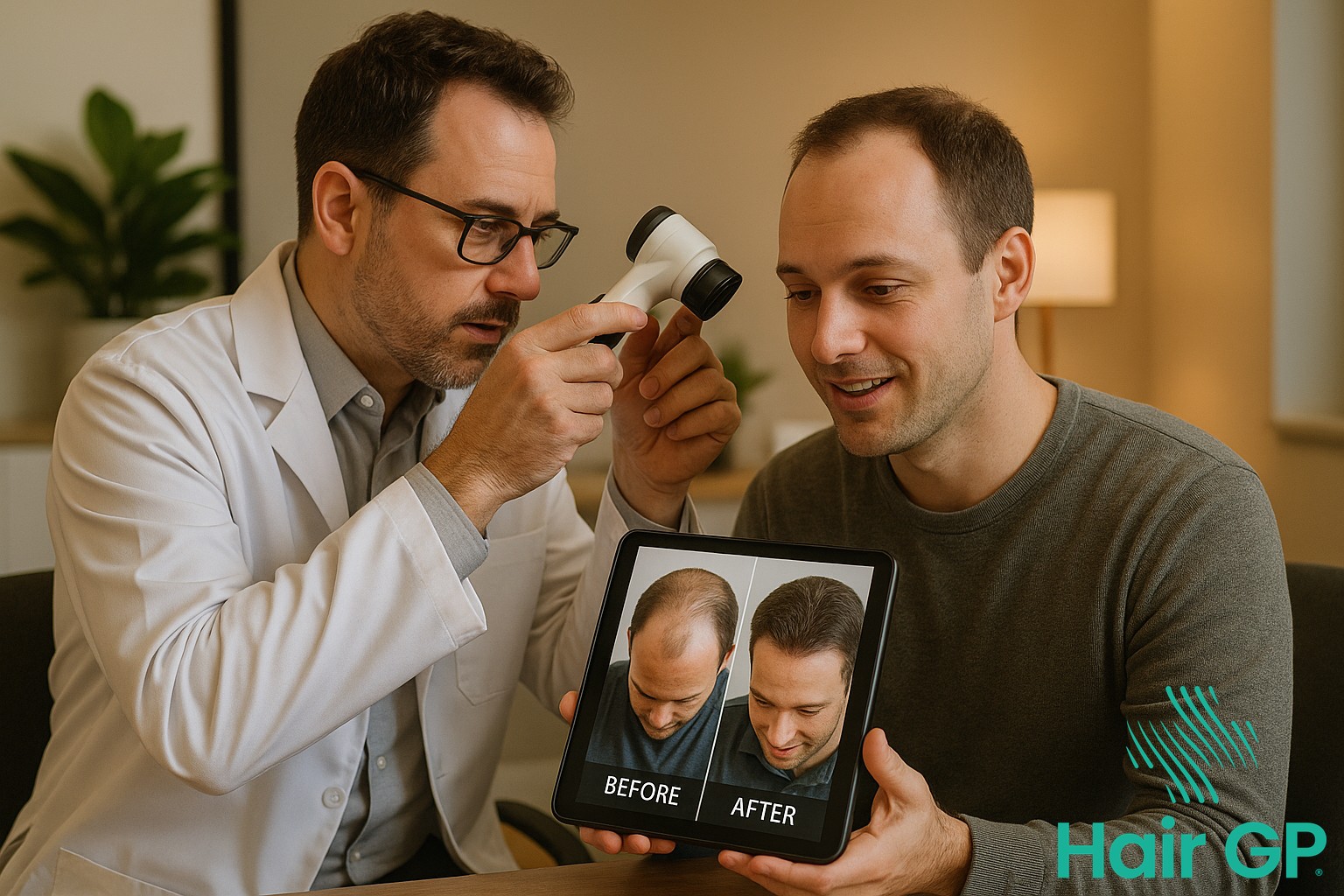
Conclusion
Both stem cells and PRP represent cutting-edge regenerative medicine approaches for hair restoration, yet they differ significantly in methodology and outcomes. Whilst platelet rich plasma therapy utilises concentrated growth factors from your blood to stimulate existing follicles, stem cell treatments can generate entirely new hair growth by creating fresh follicles. The optimal choice depends on individual hair loss patterns, severity, and treatment goals. Professional consultation remains essential to determine whether PRP’s follicle revitalisation or stem cells’ regenerative capabilities better suit your needs. Expert assessment ensures you select the most effective hair restoration strategy for lasting results.
Frequently Asked Questions
Yes, many hair restoration specialists recommend combining both treatments for enhanced results. PRP can be used as a maintenance treatment following stem cell therapy to maximize hair regrowth and maintain results longer.
PRP results typically last 12-18 months before requiring maintenance sessions. Stem cell therapy may provide longer-lasting results of 2-5 years, though individual results vary based on the severity of hair loss and overall health.
Both treatments are generally safe with minimal side effects. PRP may cause temporary scalp tenderness and mild swelling. Stem cell therapy carries similar risks plus potential discomfort at the extraction site. Serious complications are rare when performed by qualified specialists.
PRP is often recommended for early-stage hair loss and thinning as it’s less invasive and more cost-effective. It works well to strengthen existing hair follicles and prevent further loss. Stem cells may be reserved for more advanced cases or when PRP hasn’t provided desired results.
While both treatments can significantly improve hair density and thickness, they cannot replace hair transplants for advanced baldness. They work best for patients with thinning hair or early to moderate hair loss who still have active follicles to stimulate or regenerate.
References
- Gentile P, Garcovich S, Bielli A, et al. The Effect of Platelet-Rich Plasma in Hair Regrowth: A Randomized Placebo-Controlled Trial. Stem Cells Transl Med. 2015;4(11):1317-1323.
- Gupta AK, Versteeg SG, Rapaport J, et al. The Efficacy of Platelet-Rich Plasma in the Field of Hair Restoration and Facial Aesthetics—A Systematic Review and Meta-analysis. J Cutan Med Surg. 2019;23(2):185-203.
- Gentile P, Garcovich S. Advances in Regenerative Stem Cell Therapy in Androgenic Alopecia and Hair Loss: Wnt pathway, Growth-Factor, and Mesenchymal Stem Cell Signaling Impact Analysis on Cell Growth and Hair Follicle Development. Cells. 2019;8(5):466.
- Fukuoka H, Suga H. Hair Regeneration Treatment Using Adipose-Derived Stem Cell Conditioned Medium: Follow-up With Trichograms. Eplasty. 2015;15:e10.
- Gentile P, Garcovich S. Systematic Review of Platelet-Rich Plasma Use in Androgenetic Alopecia Compared with Minoxidil®, Finasteride®, and Adult Stem Cell-Based Therapy. Int J Mol Sci. 2020;21(8):2702.
- Trink A, Sorbellini E, Bezzola P, et al. A randomized, double-blind, placebo- and active-controlled, half-head study to evaluate the effects of platelet-rich plasma on alopecia areata. Br J Dermatol. 2013;169(3):690-694.

